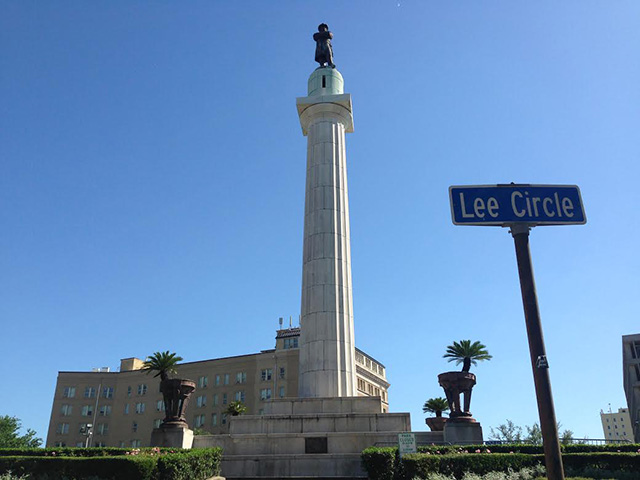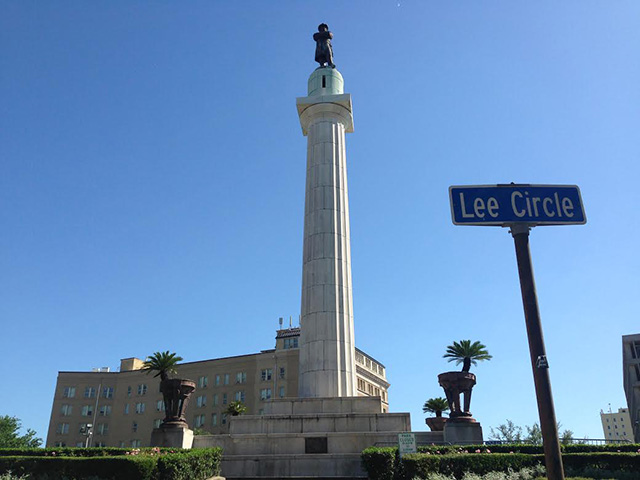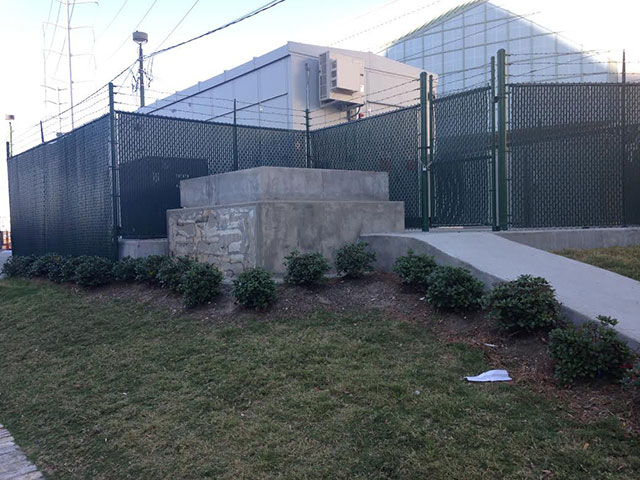
 A statue of the Confederate Gen. Robert E. Lee sits atop a large monument at the center of Lee Circle in the Central Business District of New Orleans, Louisiana. The monument is one of four being removed after years of protest by racial justice activists. (Photo: Mike Ludwig)
A statue of the Confederate Gen. Robert E. Lee sits atop a large monument at the center of Lee Circle in the Central Business District of New Orleans, Louisiana. The monument is one of four being removed after years of protest by racial justice activists. (Photo: Mike Ludwig)
New Orleans — On May 7, 1954, thousands of Black activists, students and teachers in New Orleans boycotted “McDonough Day,” an annual dedication to an early patron of the city’s public schools. Every year, white students would line up to pay their respects to a statue of the 19th century philanthropist John McDonough while Black students waited to participate in a second ceremony afterward, sometimes waiting hours in the hot southern sun.
In 1954, more than 30,000 Black students refused to show up to McDonough Day, marking one of the first major protests of the civil rights movement. Less than two weeks later, the Supreme Court declared segregation in schools to be unconstitutional, overturning Plessey vs. Ferguson, the famous “separate but equal” case that stemmed from Homer Plessey’s act of civil disobedience in New Orleans 60 years earlier.
Malcolm Suber is a longtime activist in New Orleans and a spokesman for Take ‘Em Down NOLA, a racial justice group that is pushing the city to remove symbols of white supremacy from public spaces. He says the McDonough Day Boycott marked the birth of a movement that has continued for decades, and that movement is celebrating this week as New Orleans begins the process of removing four monuments dedicated to heroes of Confederate efforts to uphold white supremacy.
“It’s big victory for our movement … the Black community has been protesting these white supremacy monuments viscerally since 1954,” Suber told Truthout.
The city took down the first of four monuments slated for removal from public spaces early Monday morning. This monument was an obelisk dedicated in 1891 to the Crescent City White League, a group of white supremacists and Confederate veterans who, in 1874, fought the Battle of Liberty Place, a Reconstruction-era insurrection against an integrated city police force and state militia.
Workers removing the monument wore protective vests and masks to conceal their identities. In a statement, Mayor Mitch Landrieu said the city would not be making public its plans for taking down the three remaining monuments because contractors bidding on the work have received death threats.
Both opponents and supporters of removing the monuments are demanding that the city be more transparent. Suber said racial justice activists want the city to make a stronger stand against the racist groups assumed to be behind the threats of violence.
“The mayor has not vigorously denounced these actions from these terrorists,” Suber said. “If we on the left had been doing the same thing, they would have come after us and put us in jail, and that’s another example of the power of the rich white folks who support the maintenance of these statues.”
The obelisk taken down on Monday is steeped in efforts to maintain white supremacy. A plaque added to the monument in 1932 explicitly honored the White League for fighting to preserve “white supremacy in the South,” and white supremacist groups have long used it as rallying point. Suber said racial justice activists clashed with Klu Klux Klan members during their annual marches to the monument in the 1980s. Police often stepped in to protect the Klan.
The city tried twice to permanently remove the monument in the 1980s and early 1990s, but agreed to place it behind a mall in the upper corner of the French Quarter, largely out of sight, after facing a legal challenge in 1992.
The removal of the obelisk has faced controversy, but there is greater public opposition to dismantling the remaining monuments that are set to be taken down: three statues dedicated to the Confederate generals Jefferson Davis, P.G.T. Beauregard and Robert E. Lee, which are located at the center of major throughways in the city.
 A concrete platform is all that remains at the former site of a monument dedicated to the Crescent City White League, a group of Confederate veterans and white supremacists who fought a Reconstruction-era battle against integrated police forces in 1874. (Photo: Mike Ludwig)
A concrete platform is all that remains at the former site of a monument dedicated to the Crescent City White League, a group of Confederate veterans and white supremacists who fought a Reconstruction-era battle against integrated police forces in 1874. (Photo: Mike Ludwig)
The push to remove Confederate monuments was renewed in 2015 as the Black Lives Matter movement rose and calls to remove public symbols of white supremacy grew, particularly in the wake of the mass murder of Black churchgoers by a racist gunman in Charleston, South Carolina.
The debate over the statues became a divisive one in New Orleans, a majority-Black city with a legacy of white supremacy, challenged first by revolting slaves and later by civil rights activists. As politicians debated the statues, opponents and supporters held regular rallies across the city. When anti-racist graffiti went up on a statue, volunteers bearing Confederate flags would gather to scrub it off. The city council agreed to remove the statues in December 2015, but the work has been delayed by legal challenges.
Outright racists have come to the defense of the statues — for example, activists faced off with avowed white nationalist David Duke during a protest last year — but other supporters contend that they are not white supremacists, and are just interested in preserving the monuments’ historical value. However, racial justice activists say that, for the city’s Black and Brown residents, the statues are a vivid reminder of southern legacies that terrorized their ancestors.
“As long as these statues are allowed to remain in the public square, they are presentations of the continued rule, real and imagined, of white supremacists and the white ruling class,” Suber said.
White supremacy is visible in New Orleans, and not just in the symbolic sense portrayed by a Confederate general on a concrete column. For example, David Duke polled well enough in a recent race for US Senate to qualify for a debate held last year at Dillard University, a historically Black college. Several activists were arrested as students attempted to shut the debate down.
Suber pointed to Louisiana’s prisons, which are disproportionately filled with Black and Brown people in a state that has the highest rate of incarceration in the country. Many workers live on low wages in the New Orleans tourist economy, and the city’s wealthier neighborhoods tend to be much whiter than the rest, many of which are under pressure from gentrification.
Suber said removing symbols of white supremacy from public spaces is part of a natural, democratic progress occurring in a city where Black people are in the majority. He added that another indicator of this progress would be the replacement of Confederate statues with public symbols that “celebrate Black culture and Black freedom and the struggle for democracy in this country.”
Suber said Take ‘Em Down NOLA’s work is far from finished. The group is demanding that the city remove a number of other monuments, including statues dedicated to historic figures that supported slavery or segregation and worked to repress Black political power.
As for the four monuments that are now being removed, they will be put in storage and eventually moved to a museum or similar facility, according to the mayor’s office.
Join us in defending the truth before it’s too late
The future of independent journalism is uncertain, and the consequences of losing it are too grave to ignore. We have hours left to raise the $12,0000 still needed to ensure Truthout remains safe, strong, and free. Every dollar raised goes directly toward the costs of producing news you can trust.
Please give what you can — because by supporting us with a tax-deductible donation, you’re not just preserving a source of news, you’re helping to safeguard what’s left of our democracy.